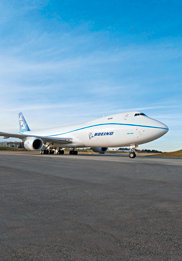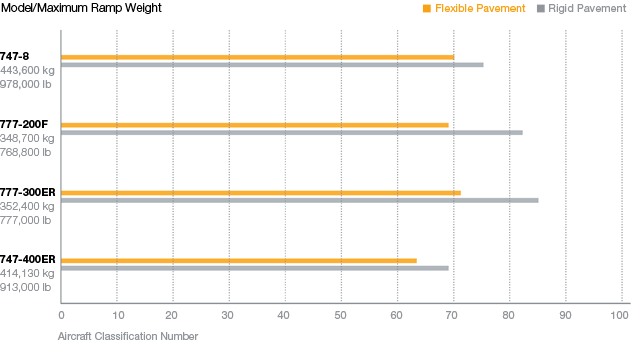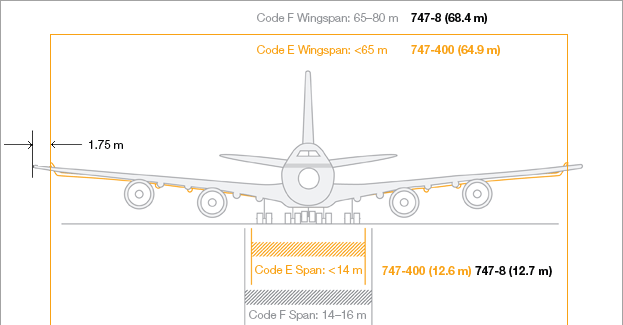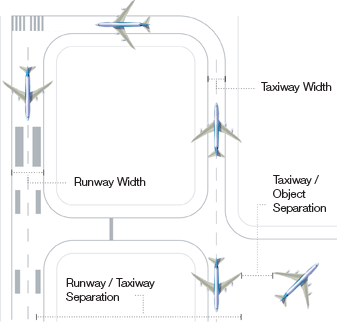

Today’s major airports are designed largely based on the critical dimensions of the 747-400. Because the 747-8 retains many of the 747-400’s key dimensions (e.g., main gear span, engine span, and tail height) and performance characteristics, many of the airfield elements at existing airports — such as runway and taxiway widths — should be compatible with the 747-8.
By Karen Dix-Colony, Product Development Lead Engineer, Airport Technology; and
Brad Bachtel, Manager, Airport Technology
The 747-8 offers operators increased capacity while taking advantage of existing airport infrastructure.
In the United States, the Federal Aviation Administration (FAA) has already approved the 747-8 for operations at airports with parallel runway and taxiway centerline distances that are the same as those required for the 747-400, which are aspects of airport compatibility. Boeing is working with the FAA, Civil Aviation Authorities (CAAs), and airports around the world to agree on clearances that would allow the 747-8 to operate safely and economically at today’s 747-400 airports.
This article provides an overview of airport design codes and how Boeing is using existing FAA and International Civil Aviation Organization (ICAO) processes to work with the world’s CAAs to demonstrate that the 747-8 airplane can operate safely on 747-400 taxiways, taxilanes, and runways.
Airplane design
Airplane dimensions were considered during the 747-8 design process so it could operate in today’s 747-400 airports safely and efficiently. It has the same exterior dimensions as the 747-400, except for an 11.4-foot (3.5-meter) wider wingspan (fully fueled) and 18.4-foot (5.6-meter) greater length. It builds on the current 747’s capability to fly into major airports worldwide, using the same pilot type ratings, and similar aircraft services and ground-support equipment (for specific details, please see Section 5 of the airplane planning manual). The airplane’s higher gross weight increases the pavement loading approximately 18 percent but is still comparable to today’s twin-aisle airplanes (see fig. 1).
Figure 1: 747-8 pavement loading comparison
The aircraft classification number describes the relative load intensity of an airplane’s main landing gear. The 747-8’s pavement loading is similar to other current twin-aisle airplanes.

Airport design codes
ICAO airplane design codes (or groups, in the case of the FAA) are based primarily on wingspan. The legacy 747 family has been categorized under ICAO Code E, which has a span limit of up to but not including 65 meters. (The FAA Group V limit is up to but not including 214 feet.) The 747-8 wingspan is about 224.4 feet (68.4 meters), making it the first Boeing commercial airplane to be categorized as Code F (or FAA Group VI) (see fig. 2). However, the 747-8’s wingspan is much less than the maximum ICAO Code F wingspan of 80 meters. (The FAA Group VI limit is 262 feet [see fig. 3].) For simplicity, and because both the ICAO and FAA share the same concept of designing airports based on critical airplane dimensions and grouping of airport sizes based on span limits, the rest of this article will reference only ICAO specifications.
Figure 2: Airport design codes (ICAO) and groups (FAA)
The FAA and ICAO categorize airplanes based on wingspan, tail height, and outer main-gear wheel span.
| FAA Advisory Circular 150/5300-13, Airport Design Airplane Design Group (Airplane Wingspan; Tail Height) |
ICAO Annex 14 – Aerodome Reference Code Element 2, Table 1-1 (Airplane Wingspan; Outer Main Gear Wheel Span) | |
|---|---|---|
Group I — <49 ft (15 m); 20 ft (6.1 m) |
Code A — <15 m (49.2 ft); <4.5 m (14.8 ft) |
|
| Group II — 49 ft (15 m) – <79 ft (24 m); 20 ft (6.1 m) – <30 ft (9.1 m) |
Code B — 15 m (49.2 ft) – <24 m (78.7 ft); 4.5 m (14.8 ft) – <6 m (19.7 ft) |
|
| Group III — 79 ft (24 m) – <118 ft (36 m); 30 ft (9.1 m) – <45 ft (13.7 m)> |
Code C — 24 m (78.7 ft) – <36 m (118.1 ft); 6 m (19.7 ft) – <9 m (29.5 ft) |
|
| Group IV — 118 ft (36 m) – <171 ft (52 m); 45 ft (13.7 m) – <60 ft (18.3 m) |
Code D — 36 m (118.1 ft) – <52 m (170.6 ft); 9 m (29.5 ft) – <14 m (45.9 ft) |
|
| Group V — 171 ft (52 m) – <214 ft (65 m); 60 ft (18.3 m) – <66 ft (20.1 m) |
Code E — 52 m (170.6 ft) – <65 m (213.3 ft); 9 m (29.5 ft) – <14 m (45.9 ft) |
|
| Group VI — 214 ft (65 m) – <262 ft (80 m); 66 ft (20.1 m) – <80 ft (24.4 m) |
Code F — 65 m (213.3 ft) – <80 m (262.5 ft); 14 m (45.9 ft) – <16 m (52.5 ft) |
Figure 3: ICAO Design Code: 747-8 compared to 747-400
The 747-8’s wingspan and main-gear span are only slightly larger than those of the 747-400, but the new airplane is classified as Code F while the previous models are Code E.

In terms of airport requirements, one of the differences between ICAO Code E and Code F is the Runway-to-Taxiway separation requirement, which is 598.7 feet (182.5 meters) for Code E and 623 feet (190 meters) for Code F. Many of today’s major airports have been constructed with Code E separations, so full compliance with ICAO standards would force them to remove existing taxiways and rebuild them an additional 24.6 feet (7.5 meters) away from one another. Another major difference is the taxiway-to-object separation requirement, which is 155.8 feet (47.5 meters) for ICAO Code E and 188.6 feet (57.5 meters) for Code F. In order for an ICAO Code E airport to be improved to be in full compliance to Code F standards, an additional 32.8 feet (10 meters) of separation is recommended. These infrastructure changes would not only be cost-prohibitive but could also impact the airport’s overall capacity during construction, assuming the airport even had enough land to accommodate the increased spacing (see fig. 4). Although the 747-8 wingspan of 224.4 feet (68.4 meters) is at the low end of the Code F range (213.3–262.5 feet/65–80 meters), the 747-8 will be treated as if it has the same span as a larger airplane that is near the upper limit of Code F range for airport design criteria.
Figure 4: ICAO Code F compared to Code E
Full compliance with ICAO airport requirements would mean relocating taxiways and other airfield elements.
| Airfield Characteristics | ICAO Code E / F | |
| Meters | Feet | |
| Runway Width | 45 / 60 | 148 / 197 |
| Runway + Shoulder Width | 60 / 75 | 197 / 246 |
| Taxiway Width | 23 / 25 | 75 / 82 |
| Taxiway + Shoulder Width | 44 / 60 | 144 / 197 |
| Runway – Taxiway Separation | 182.5 / 190 | 599 / 623 |
| Taxiway – Taxiway Separation | 80 / 97.5 | 262 / 320 |
| Taxiway – Object Separation | 47.5 / 57.5 | 156 / 189 |
| Taxilane – Object Separation | 42.5 / 50.5 | 139 / 166 |

As a result, and after careful analysis, many aviation authorities are approving exemptions to the ICAO Code F/FAA Group VI design requirement to allow operations of the 747-8 at existing Code E/Group V airports through the use of aeronautical safety studies. For example, the FAA has determined that the Boeing 747-8, which is classified as an Airport Design Group (ADG) VI category airplane, can operate safely on taxiways that have been designed to ADG V standards, and at airports where the ADG taxiway/runway separation distances are built to ADG V standards. For runway operations, Boeing incorporated into the 747-8 flight test program a plan to collect data to demonstrate that the 747-8 can operate safely on an ADG V runway width of 150 feet (45.7 meters). The ADG VI requirement is 200 feet (61 meters).
In some cases, airports can accommodate the airplane on the airport movement areas through the use of operational procedures. For example, when a 747-8 is taxiing, operations on a parallel taxiway that is built to less than the required separation standards may be limited to airplanes with a smaller wingspan in order to maintain adequate separation clearances.
Evaluating 747-8 operations at 747-400 airports
During the last four years, Boeing has worked with approximately 80 CAAs and more than 200 airports around the world to evaluate 747-8 operations at 747-400 airports. There are only a dozen or so airports worldwide where the major movement areas are built to Code F standards (e.g., Hong Kong-HKG, Dubai-DXB, and Narita-NRT). In fact, many of the airports where the 747-400 operates today are built to less than Code E standards. As larger airplanes enter the fleet, airports are beginning to upgrade their infrastructure and represent a mixture of Code D, Code E, and Code F (e.g., Los Angeles-LAX and New York-JFK).
United States. Boeing has been working with U.S. airports to employ the FAA’s modification of standards (MOS) process to ensure that 747-8 operators can fly into and out of the same airports as with previous 747 models. The MOS process calls for an airport to carefully study those areas of the airfield that are built to less than ADG VI design standards. When existing airfield conditions preclude compliance with ADG VI design standards, the airport can submit a proposal (based on a safety study) for operations that maintain an acceptable level of safety. The FAA then reviews the proposal and determines whether or not an MOS will be approved. In cases where existing gates and cargo facilities were not built to accommodate the 747-8 wingspan, most U.S. airports will either reduce the size of adjacent gates or use terminal corners where gates are sized more generously.
Europe. Boeing has partnered with the Airports Council International, major European airlines, airports, and CAAs to form the Boeing 747-8 Airport Compatibility Group. Based on the methodology of ICAO Circular 305, “Operation of New Larger Aeroplanes at Existing Aerodromes,” the group developed a set of minimum separation criteria for safe 747-8 operations. It concluded that the 747-8 can safely operate in airports built to ICAO Code E standards. Boeing is encouraging the CAAs and airports in other regions of the world to use the Boeing Airport Compatibility Group’s minimum separation criteria to help them perform their own aeronautical safety study of 747-8 operations. These results can help facilitate approval for the 747-8 to operate at their airport. As with the U.S. airports, to accommodate the 747-8’s wider wingspan at gates, most major airports will either reduce the size of adjacent gates or use terminal corners where gates are sized more generously.
Rest of the world. Some other countries, such as the United Kingdom and Canada, have their own process to accommodate the 747-8 at their 747-400 airports. In countries without a process, Boeing is working with the CAAs to ensure that an aeronautical safety study is conducted according to ICAO Circular 305. The results of the study can be used to determine how 747-8 operations can be safely conducted in their less than Code F airports. If needed, an operational plan can then be used to help facilitate approval for the 747-8 to operate at each airport.
Summary
The 747-8 offers operators increased capacity while taking advantage of existing airport infrastructure. Because its wingspan puts it into the ICAO Code F group, performance of an aeronautical study and, in some cases, application of operational procedures will allow the airplane to operate at existing 747-400 airports.
For more information about airport compatibility, please contact Karen Dix-Colony.

